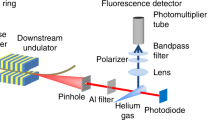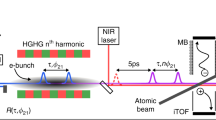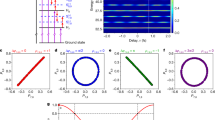Abstract
In ultrafast spectroscopy, the temporal resolution of time-resolved experiments depends on the duration of the pump and probe pulses, and on the control and characterization of their relative synchronization. Free-electron lasers operating in the extreme ultraviolet and X-ray spectral regions deliver pulses with femtosecond and attosecond duration in a broad array of pump–probe configurations to study a wide range of physical processes. However, this flexibility, together with the large dimensions and high complexity of the experimental set-ups, limits control of the temporal delay to the femtosecond domain, thus precluding a time resolution below the optical cycle. Here we demonstrate a novel single-shot technique able to determine the relative synchronization between an attosecond pulse train—generated by a seeded free-electron laser—and the optical oscillations of a near-infrared field, with a resolution of one atomic unit (24 as). Using this attosecond timing tool, we report the first example of attosecond coherent control of photoionization in a two-colour field by manipulating the phase of high-order near-infrared transitions.
This is a preview of subscription content, access via your institution
Access options
Access Nature and 54 other Nature Portfolio journals
Get Nature+, our best-value online-access subscription
$29.99 / 30 days
cancel any time
Subscribe to this journal
Receive 12 print issues and online access
$209.00 per year
only $17.42 per issue
Buy this article
- Purchase on Springer Link
- Instant access to full article PDF
Prices may be subject to local taxes which are calculated during checkout





Similar content being viewed by others
Data availability
Experimental data were generated at the FERMI large-scale facility. The experimental and simulations data included in this work are available on the open repository: https://zenodo.org/record/7015967#.YwQTS-xBxQJ. Additional derived data supporting the findings of this study are available from the corresponding author on reasonable request.
References
Duris, J. et al. Tunable isolated attosecond X-ray pulses with gigawatt peak power from a free-electron laser. Nat. Photon. 14, 30–36 (2020).
Maroju, P. K. et al. Attosecond pulse shaping using a seeded free-electron laser. Nature 578, 386–391 (2020).
Bostedt, C. et al. Linac Coherent Light Source: the first five years. Rev. Mod. Phys. 88, 015007 (2016).
Rossbach, J., Schneider, J. R. & Wurth, W. 10 Years of pioneering X-ray science at the free-electron laser FLASH at DESY. Phys. Rep. 808, 1–74 (2019).
Callegari, C. et al. Atomic, molecular and optical physics applications of longitudinally coherent and narrow bandwidth free-electron lasers. Phys. Rep. 904, 1–59 (2021).
Allaria, E. et al. Two-colour pump-probe experiments with a twin-pulse-seed extreme ultraviolet free-electron laser. Nat. Commun. 4, 2476 (2013).
Lutman, A. A. et al. Experimental demonstration of femtosecond two-color X-ray free-electron lasers. Phys. Rev. Lett. 110, 134801 (2013).
Hara, T. et al. Two-colour hard X-ray free-electron laser with wide tunability. Nat. Commun. 4, 2919 (2013).
Prince, K. C. et al. Coherent control with a short-wavelength free-electron laser. Nat. Photon. 10, 176–179 (2016).
Maroju, P. K. et al. Analysis of two-color photoelectron spectroscopy for attosecond metrology at seeded free-electron lasers. New J. Phys. 23, 043046 (2021).
Maroju, P. K. et al. Complex attosecond waveform synthesis at FEL FERMI. Appl. Sci. 11, 9791 (2021).
Iablonskyi, D. et al. Observation and control of laser-enabled auger decay. Phys. Rev. Lett. 119, 073203 (2017).
You, D. et al. New method for measuring angle-resolved phases in photoemission. Phys. Rev. X 10, 031070 (2020).
Danailov, M. B. et al. Towards jitter-free pump-probe measurements at seeded free electron laser facilities. Opt. Express 22, 12869 (2014).
Harmand, M. et al. Achieving few-femtosecond time-sorting at hard X-ray free-electron lasers. Nat. Photon. 7, 215–218 (2013).
Schulz, S. et al. Femtosecond all-optical synchronisation of an X-ray free-electron laser. Nat. Commun. 6, 5938 (2015).
Grychtol, P. et al. Timing and X-ray pulse characterization at the Small Quantum Systems instrument of the European X-ray Free Electron Laser. Opt. Express 29, 37429 (2021).
Juranić, P. N. et al. High-precision X-ray FEL pulse arrival time measurements at SACLA by a THz streak camera with Xe clusters. Opt. Express 22, 30004 (2014).
Paul, P. M. et al. Observation of a train of attosecond pulses from high harmonic generation. Science 292, 1689–1692 (2001).
Mairesse, Y. et al. Attosecond synchronization of high-harmonic soft X-rays. Science 302, 1540–1543 (2003).
Véniard, V., Taïeb, R. & Maquet, A. Phase dependence of (N + 1)-color (N > 1) ir–uv photoionization of atoms with higher harmonics. Phys. Rev. A 54, 721–728 (1996).
Agostini, P. & DiMauro, L. F. The physics of attosecond light pulses. Rep. Prog. Phys. 67, 813 (2004).
Krausz, F. & Ivanov, M. Attosecond physics. Rev. Mod. Phys. 81, 163 (2009).
Allaria, E. et al. Highly coherent and stable pulses from the FERMI seeded free-electron laser in the extreme ultraviolet. Nat. Photon. 6, 699–704 (2012).
Svetina, C. et al. The Low Density Matter (LDM) beamline at FERMI: optical layout and first commissioning. J. Synchr. Radiat. 22, 538–543 (2015).
Lewenstein, M., Balcou, P., Ivanov, M. Y., L’Huillier, A. & Corkum, P. B. Theory of high-harmonic generation by low-frequency laser fields. Phys. Rev. A 49, 2117 (1994).
Shapiro, M. & Brumer, P. Coherent control of molecular dynamics. Rep. Prog. Phys. 66, 859 (2003).
Ranitovic, P. et al. Attosecond vacuum UV coherent control of molecular dynamics. Proc. Natl Acad. Sci. USA 111, 912–917 (2014).
Ranitovic, P. et al. Attosecond coherent control of oxygen dissociation by XUV-IR laser fields using three-dimensional momentum. Phys. Rev. A 98, 013410 (2018).
Kelkensberg, F. et al. Attosecond control in photoionization of hydrogen molecules. Phy. Rev. Lett. 107, 043002 (2011).
Peng, P. et al. Coherent control of ultrafast extreme ultraviolet transient absorption. Nat. Photon. 16, 45–51 (2022).
Swoboda, M. et al. Intensity dependence of laser-assisted attosecond photoionization spectra. Laser Phys. 19, 1591–1599 (2009).
Mauritsson, J., Gaarde, M. B. & Schafer, K. J. Accessing properties of electron wave packets generated by attosecond pulse trains through time-dependent calculations. Phys. Rev. A 72, 013401 (2005).
Schafer, K. J. & Kulander, K. C. Energy analysis of time-dependent wave functions: application to above-threshold ionization. Phys. Rev. A 42, 5794–5797 (1990).
Feldhaus, J. et al. Possible application of X-ray optical elements for reducing the spectral bandwidth of an X-ray SASE FEL. Opt. Comm. 140, 341–352 (1997).
Hemsing, E. et al. Soft X-ray seeding studies for the SLAC Linac Coherent Light Source II. Phys. Rev. Accel. Beams 22, 110701 (2019).
Amann, J. et al. Demonstration of self-seeding in a hard-X-ray free-electron laser. Nat. Photon. 6, 693–698 (2012).
Geloni, G., Kocharyan, V. & Saldin, E. A novel self-seeding scheme for hard X-ray FELs. J. Mod. Opt. 58, 1391 (2011).
Inoue, I. et al. Generation of narrow-band X-ray free-electron laser via reflection self-seeding. Nat. Photon. 13, 319–322 (2019).
Min, C.-K. et al. Hard X-ray self-seeding commissioning at PAL-XFEL. J. Synchr. Rad. 26, 1101–1109 (2019).
Lutman, A. A. et al. Demonstration of single-crystal self-seeded two-color X-Ray free-electron lasers. Phys. Rev. Lett. 113, 254801 (2014).
Dahlstrom, J. M., L’Huillier, A. & Maquet, A. Introduction to attosecond delays in photoionization. J. Phys. B 45, 183001 (2012).
Pazourek, R., Nagele, S. & Burgdörfer, J. Attosecond chronoscopy of photoemission. Rev. Mod. Phys. 87, 765–802 (2015).
Isinger, M. et al. Photoionization in the time and frequency domain. Science 358, 893–896 (2017).
Biswas, S. et al. Probing molecular environment through photoemission delays. Nat. Phys. 16, 778–783 (2020).
Ahmadi, H. et al. Attosecond photoionisation time delays reveal the anisotropy of the molecular potential in the recoil frame. Nat. Commun. 13, 1242 (2022).
Cattaneo, L. et al. Attosecond coupled electron and nuclear dynamics in dissociative ionization of H2. Nat. Phys. 14, 733–738 (2018).
Garg, M. & Kern, K. Attosecond coherent manipulation of electrons in tunneling microscopy. Science 367, 411–415 (2020).
Vanacore, G. M. et al. Attosecond coherent control of free-electron wave functions using semi-infinite light fields. Nat. Commun. 9, 2694 (2018).
Finetti, P. et al. Pulse duration of seeded free-electron lasers. Phys. Rev. X 7, 021043 (2017).
Squibb, R. J. et al. Acetylacetone photodynamics at a seeded free-electron laser. Nat. Commun. 9, 63 (2018).
Acknowledgements
We acknowledge the contribution of N. Pal in the preparation of the magnetic bottle electron spectrometer used in the experiment. This project has received funding from the European Union’s Horizon 2020 research and innovation programme under the Marie Sklodowska-Curie grant agreement no. 641789 MEDEA. K.U. acknowledges support from the X-ray Free Electron Laser Utilization Research Project and the X-ray Free Electron Laser Priority Strategy Program of the Ministry of Education, Culture, Sports, Science and Technology of Japan (MEXT); from the Cooperative Research Program of ‘Network Joint Research Center for Materials and Devices: Dynamic Alliance for Open Innovation Bridging Human, Environment and Materials’; from the bilateral project CNR-JSPS ‘Ultrafast science with XUV Free Electron Lasers’; and from the IMRAM project for the international co-operation. R.F. and J.M. thank the Swedish Research Council (VR) and the Knut and Alice Wallenberg Foundation for financial support. D.B. acknowledges support from the Swedish Research Council grant 2020-06384. Research at Louisiana State University was supported by the US Department of Energy, Office of Science, Basic Energy Sciences, under contract no. de-sc0010431. Portions of this research were conducted with high-performance computing resources provided by Louisiana State University (http://www.hpc.lsu.edu) and Louisiana Optical Network Infrastructure (http://hpc.loni.org). P.K.M, B.M., R.S. and G.S. acknowledge financial support from the Deutsche Forschungsgemeinschaft Research Training Group DynCAM (RTG 2717), Priority Program 1840 (QUTIF) and grant 429805582 (project SA 3470/4-1). P.K.M acknowledges financial support from Wissenschaftliche Gesellschaft Freiburg im Breisgau. I.M. and G.S. acknowledge financial support from the BMBF project 05K19VF1.
Author information
Authors and Affiliations
Contributions
P.K.M., M.D.F., O.P., M.B., B.M., D.B., I.M., M.S., R.S., S.B., E.R.S., T.C., M.D., S.K., K.U., F.F., L.P., K.C.P., J.M., C.C. and G.S. contributed to data acquisition. P.R.R., L.G., G.D.N, C.S. and G.P. operated the machine and designed the three- and four-harmonic generation scheme. M.Z. and A.S. optimized the transport and focusing of the FEL pulses to the end station. M.M. analysed the spatial properties of the phase profile of the XUV beam. A.D. and M. Danailov. designed the set-up for the NIR pulse delivery. M.D.F., O.P., M.B., C.C. prepared the end station. J.L. and K.J.S. contributed with simulations. R.J.S. and R.F. constructed and operated the magnetic bottle electron spectrometer, where parts of its operation mode were conceptually devised for this experiment. P.K.M., C.C. and G.S. conceived the idea of the experiment. P.K.M. performed the data analysis. P.K.M. and G.S. performed the simulations. G.S. supervised the work and wrote the manuscript, which was discussed and agreed by all co-authors.
Corresponding author
Ethics declarations
Competing interests
The authors declare no competing interests.
Peer review
Peer review information
Nature Photonics thanks Zenghu Chang, Fernando Martín, Predrag Ranitovic and the other, anonymous, reviewer(s) for their contribution to the peer review of this work.
Additional information
Publisher’s note Springer Nature remains neutral with regard to jurisdictional claims in published maps and institutional affiliations.
Supplementary information
Supplementary Information
Supplementary Methods, Figs. 1–7, Tables 1 and 2, equations and experimental information.
Rights and permissions
Springer Nature or its licensor (e.g. a society or other partner) holds exclusive rights to this article under a publishing agreement with the author(s) or other rightsholder(s); author self-archiving of the accepted manuscript version of this article is solely governed by the terms of such publishing agreement and applicable law.
About this article
Cite this article
Maroju, P.K., Di Fraia, M., Plekan, O. et al. Attosecond coherent control of electronic wave packets in two-colour photoionization using a novel timing tool for seeded free-electron laser. Nat. Photon. 17, 200–207 (2023). https://doi.org/10.1038/s41566-022-01127-3
Received:
Accepted:
Published:
Issue Date:
DOI: https://doi.org/10.1038/s41566-022-01127-3
This article is cited by
-
Ultrafast quantum control of atomic excited states via interferometric two-photon Rabi oscillations
Communications Physics (2024)
-
Experimental demonstration of attosecond pump–probe spectroscopy with an X-ray free-electron laser
Nature Photonics (2024)
-
An X-ray free-electron laser with a highly configurable undulator and integrated chicanes for tailored pulse properties
Nature Communications (2023)



